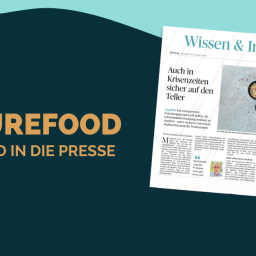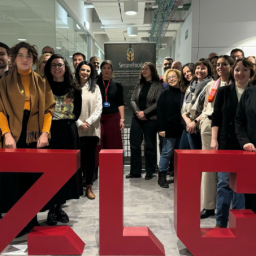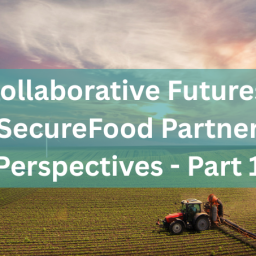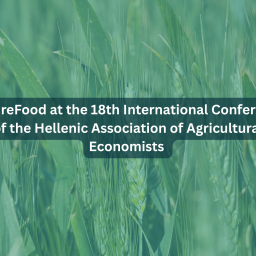
As part of our new two-part interview series, we spoke with participants of Work Package 2 (WP2), Galanakis Laboratories, EMPRACTIS L.P., and the Institute of Communication and Computer Systems, to discuss the analytical core of the project. In SecureFood, WP2 focuses on mapping Europe’s food security landscape, identifying key vulnerabilities, and designing the frameworks that will guide the project’s digital and policy solutions. In this first part of our conversation, our partners discuss why this work matters, what the team has learned so far about the gaps in Europe’s food systems, and how insights from stakeholders and end-users are shaping SecureFood’s direction.
1. To start off, could you give us an overview of what WP2 focuses on, and why it’s such an important part of SecureFood?
WP2 is the analytical backbone of the SecureFood project. It is designed to ensure that every tool, framework and strategy we develop is grounded in solid evidence and directly aligned with real-world needs. The work package has four main components: first, mapping the current state of play and identifying policy and practice gaps; second, analysing the drivers of food security that shape resilience and vulnerability; third, capturing user requirements and defining practical use cases with measurable performance indicators; and fourth, designing a high-level system architecture that allows all solutions to work together as one ecosystem.
This is of urgent importance, given that food systems are facing multifaceted pressures that are increasingly systemic and interdependent. Climate change, geopolitical disruptions and economic volatility make supply chains fragile, while further alignment and integration of European policies are needed to address existing gaps in food system resilience. Although food systems have been designated as critical infrastructure, this recognition is not yet fully reflected in policy action or societal awareness. Climate adaptation measures remain only partially integrated into agricultural policy, and binding regulations on food loss and waste are still lacking. Stakeholders consistently emphasize that the most critical priorities are ensuring access to and availability of food, alongside the long-term need for sustainability.
By integrating rigorous policy analysis, stakeholder engagement and system design, WP2 ensures that SecureFood effectively addresses both structural weaknesses and vulnerabilities across the food supply chains. It lays the project’s foundation for a coherent framework, enabling the development not only digital tools, but a cohesive and inclusive ecosystem that strengthens Europe’s capacity to maintain resilient secure and sustainable food supplies.
2. When you looked at the “state of play,” what did you learn about the main gaps or weaknesses in today’s food security systems?
The state-of-play analysis revealed that Europe’s food systems remain highly vulnerable and fragmented. One significant gap is that food is not yet prioritized as critical infrastructure in EU resilience policies, despite disruptions to supply chains having impacts as severe as those of energy or transport crises. Agricultural policy is also misaligned with climate goals, as the Common Agricultural Policy has not fully integrated long-term adaptation strategies into its framework. At the same time, food loss and waste remain largely unregulated, with no binding rules for monitoring and reduction.
Another weakness is Europe’s dependency on imports of fertilizers, feed and other essential inputs, which exposes the system to geopolitical risks. Risk monitoring at the regional level is inconsistent and there is no unified system to address localized vulnerabilities. During crises, coordination across Member States remains fragmented, making systemic responses difficult.
Stakeholders added another layer of insight. Climate change, market volatility and supply chain inefficiencies were consistently identified as the top hazards. Yet, very few organizations conduct risk assessments or maintain resilience plans. The adoption of digital tools is also uneven, with larger companies integrating forecasting and monitoring technologies more effectively, while smaller producers struggle due to limited financial resources and knowledge barriers.
All of these factors highlight that Europe’s food security is undermined not only by external shocks but also by internal governance and implementation gaps. Addressing these weaknesses requires both systemic governance reforms and the deployment of practical, interoperable digital tools; exactly what SecureFood is designed to provide.
3. What are “food security drivers,” and why are they important for SecureFood?
Food security drivers are the underlying forces that determine whether food systems are strong, resilient, or fragile and exposed. These include environmental factors such as climate variability, soil health and water scarcity; technological developments like digital traceability and predictive analytics; economic pressures including market volatility, input dependencies and trade patterns; political and institutional factors such as governance frameworks and agricultural policy; and socio-cultural dynamics like consumer behavior, demographics and dietary shifts.
Their importance lies in moving beyond symptoms to root causes. For instance, repeated supply disruptions are not just random shocks. They reflect deeper vulnerabilities, such as climate instability, dependency on imports, or weak governance coordination. Stakeholders validated this by ranking food availability and access as the most urgent pillars, while also acknowledging sustainability as a long-term priority. Climate change, geopolitical instability and economic shocks were seen as the most pressing risks.
For SecureFood, focusing on drivers ensures that our interventions target the dynamics that really matter. Tools such as early warning systems, digital twin and waste optimization platform are designed to directly respond to these drivers. By aligning solutions with both immediate and structural drivers, SecureFood makes sure its outputs are practical, scalable and relevant for strengthening resilience across Europe’s food systems.
4. How did you go about gathering information and insights from stakeholders such as policymakers, industry, or communities?
Our approach combined both top-down policy analysis and bottom-up stakeholder engagement. First, we carried out a Europe-wide survey that gathered perspectives on food security hazards, resilience challenges and organizational preparedness. The results showed that fewer than half of organizations regularly conduct risk assessments, and even fewer maintain structured resilience plans.
Second, we used targeted questionnaires for four core sectors: grains, milk and dairy, fruits and vegetables, and fish and aquaculture. These highlighted sector-specific vulnerabilities include fertilizer dependency in arable farming, high waste levels in fresh produce chains and climate sensitivity in fish and aquaculture.
Third, we organized focus groups and validation workshop with farmers, processors and industry representatives, transport operators, suppliers, local authorities and policymakers. Using interactive tools such as live polling, these sessions allowed us to capture stakeholders’ needs and expectations regarding SecureFood solutions, refine user requirements in line with broader community’s priorities and ensure that the proposed solutions are aligned with practical implementation contexts.
Finally, we analysed EU strategies and standards (from Farm to Fork and CAP to ISO and Codex guidelines) to identify gaps between policy objectives and practical implementation. Bringing together these strands ensured that SecureFood reflects the realities of both governance frameworks and the daily challenges of food system actors, developing solutions that are credible, inclusive and actionable.
5. What kind of feedback did you receive from end-users like farmers, suppliers, or local authorities? What are they most hoping to get out of SecureFood?
End-users were very clear in their feedback: they want tools that are predictive, easy to use and designed to promote cooperation across the supply chain. Farmers emphasized the importance of early-warning systems to forecast extreme weather, pests or market disruptions, as current agricultural policy provides little long-term support for adaptation. Suppliers and transport operators emphasized the importance of route optimization and incident reporting, as disruptions in logistics frequently leave them without viable alternatives.
Local authorities emphasized the need for effective communication platforms to facilitate coordinated crisis response. They pointed out that fragmented governance means each sector often acts on different timelines, creating confusion during disruptions. They requested real-time, multilingual and interoperable tools that could connect all stakeholders within a single system.
Retailers and processors consistently raised the issue of food waste, calling for tools to help track, redistribute or repurpose surplus stock, filling the gap left by the absence of binding EU waste regulations. Across the board, affordability and usability were top concerns, especially for small-scale farms and SMEs that struggle with digital adoption.
Conclusively, end-users want SecureFood to provide early alerts, predictive simulations capabilities, actionable recommendations, effective coordination mechanisms, waste reduction solutions and user-friendly tools that are practical and applicable in real-world contexts.
WP2’s early findings reveal not just where Europe’s food systems are most vulnerable, but also what farmers, suppliers, and policymakers need from practical resilience tools. These insights form the foundation for the next phase of SecureFood’s work, and will help to turn evidence and feedback into real-world applications.
In the second part of this interview, our partners explain how these ideas are being transformed into concrete use cases, system architecture, and strategies for lasting impact
The SecureFood project is funded by the European Union’s Horizon Europe research and innovation programme under grant agreement No. 101136583. Views and opinions expressed are however those of the author(s) only and do not necessarily reflect those of the European Union or the European Research Executive Agency (REA). Neither the European Union nor the granting authority can be held responsible for them.
Follow us on:
LinkedIn: SecureFood
BlueSky: @securefoodeu.bsky.social
X: @SecureFoodEU






